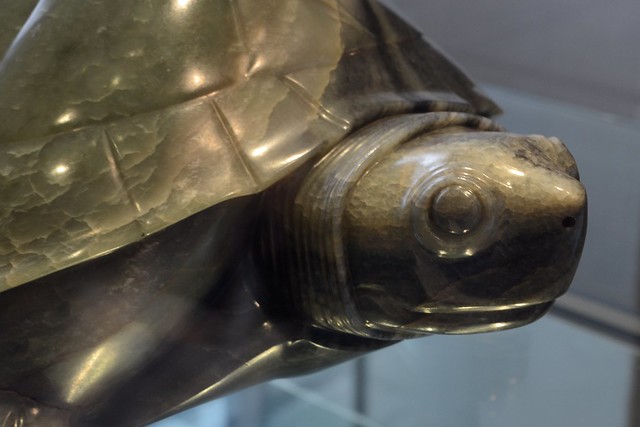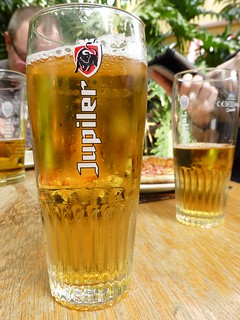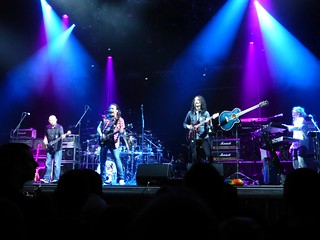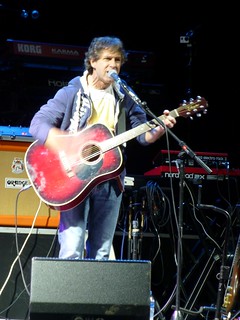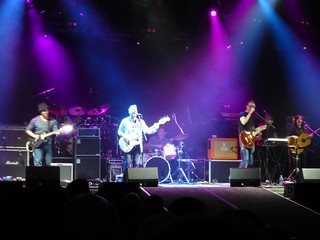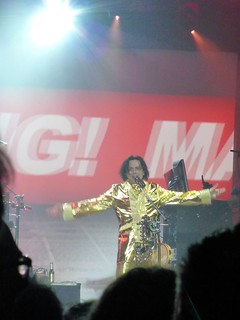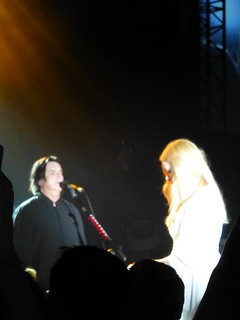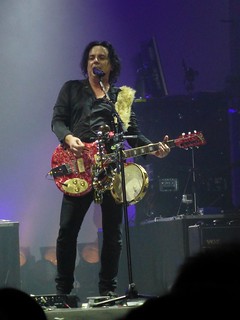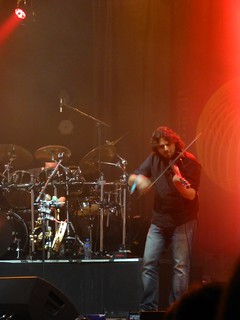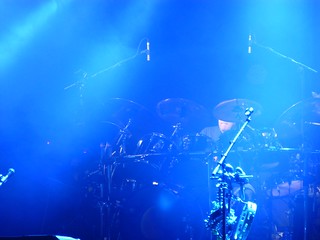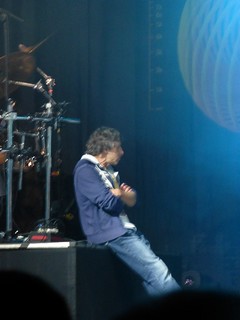Marillion Weekends are held every 2 years, and on March 8-10th was the 10th convention – J and I have been to every one of them so far 🙂 This year, as with the last 3, it was held at the Center Parcs at Port Zélande, in the Netherlands. The current format is the band play 3 gigs, one each on Friday, Saturday & Sunday, complete with support bands and a long set from Marillion. There’s also stuff during the Saturday & Sunday afternoons, including a pub quiz about the band where the final is the fan winners vs. the band. And Swap the Band where fans get to play on stage with the band in place of one of the band members.

As I said, J & I have been to all of these conventions, from the first one which was just an evening in a small club in Oxford (The Zodiac) in 1998. (At first they were more frequent than every two years, as well as smaller.) We’ve had a selection of different people join us over the years. This year there were seven of us in our group – me, J, Paul, Ady, Ellen, Avi and Gordon.
Photos are up on flickr, I’ve just put some highlights in this post. I only took the point & shoot camera with me, not my DSLR – too faffy to have the big camera in a gig, and harder to hold over my head to take the pictures. J took most of the photos of our group, btw.
Friday 8th March
My notes emphasise beer … funnily enough 🙂 Those of us coming by car (Paul drove himself, me & J and Ady from Ipswich) got up at brutal o’clock (ie 4am) and got to Center Parcs around 1330 local time, in time for lunch and BEER! 🙂 We met the others (who came by plane and shuttle bus) afterwards, while we were buying merch, then got settled in at the chalet before our dinner.
The evening’s concert started off with a set from DeeExpus (who we’ve seen support Marillion before). And as was the case then – I enjoyed the set while they were playing, but I still haven’t listened to the album at home.
And then it was on to the main act 🙂 Marillion came out and played through the whole of their album Radiation – which was released in 1998, so is 15 years old. I think it was the first album released after I’d got into the band, so I feel a trifle old now 😉 It’s an album that’s not had all that good a reaction from “fans in general” in the past, because the mix is thought to be a bit sub-par – but live the tracks have always rocked, so they’ve re-released it this year with a new mix. This set included several tracks I like live – and one that’s gradually becoming a favourite of mine: A Few Words for the Dead. Since they toured Sounds That Can’t Be Made h has been doing some playacting with a fake rifle during this song & it adds something to it, to me.
The second half of the set after a short break was very much the bouncy set of the weekend – and could’ve been designed for me. Several Fish era songs (including Script for a Jester’s Tear which is one of my favourite Marillion songs), and the h era songs included both Hooks in You and Cover My Eyes. I bounced up & down till my feet hurt, and sang so much my voice went a bit 🙂
Afterwards those of us that were staying out (me, J, Paul, Ellen & Ady) walked briskly to the Adventure Factory (yeah, that’s the name of the bit where the bar was) and got beer. There was a queue from hell for beer from the bar, so we won’t dwell upon that – aggravating tho it was, we did end up with a sufficient quantity of beer 😀 About 1am we headed back to the chalet and I think in the end we stayed up till 3am chattering away – only 22hrs since we’d got up in the morning!
Saturday 9th March
Funnily enough, I started the day with a mild hangover, can’t think why 😉 Didn’t stop me having a few beers during the afternoon – although perhaps it should’ve done coz the hangover came back for the evening, oops :/ Gave away the beer I’d bought at the start of the gig and drank coke for the rest of it – caffeine, sugar, liquid, perfect hangover cure, shame about the taste!
The first of the support acts was Pete Trewavas doing a “solo” set – I put it in quotes because he had someone whose name I forget come on stage with him for a couple of the songs. But it was all his own music, and mostly himself singing and playing guitar. He kept saying he was nervous, but it didn’t really show. And obviously he got a good reception, because he’s part of Marillion. The second support act were Sweet Billy Pilgrim, who I have to confess passed me by entirely. Pleasant yet un-memorable would be my take on them, but everyone else really liked them. Perhaps the previous paragraph explains it, and I just wasn’t in the right head space for the band?
The first half of Marillion’s set was a play through of the album Brave in it’s entirety. Previous conventions have normally done an album play-through on the Friday night, this is the first time we’ve had a whole album on the Saturday night as well. And this is the first time we’ve had a repeat of an album as well – they played Brave at the convention at Pontins back in 2002. Brave as an album is a pretty emotional (and bleak) piece of work – it’s inspired by a news story about a girl found wandering about on/preparing to jump from the Severn Bridge who refused to tell her rescuers who she was or why she was there. The songs on the album are possible stories for how she ended up there. To be perfectly honest, this is not one of my favourite Marillion albums. Everyone you talk to about it says it’s an album to sit down and listen to – lights off, volume up, read the lyrics, give it your full attention. And I don’t really interact with music that way – I stick it on as background, and sing along with the stuff I know or dance round the living room (depending how many people can see me …). So Brave passes me by a bit on record. It’s still a powerful experience live. And it’s enhanced when the band play it as a whole album because the stage show to go with it involves h acting out some of the bits as well as the music playing. So there were bits with a girl in a white dress (Jennifer Rothery, the guitarist’s daughter) lighting candles round h during an atmospheric bit, masked men pulling h off stage etc.
We’d known for weeks that Brave would be played on this evening, so we’d been speculating about what the second set would consist of – I was assuming (and asserting) that it’d be all the more emotional songs, to continue the theme. And I wasn’t entirely wrong, this was the evening they played Out Of This World complete with the film of the Bluebird crash – always an emotional moment. But they did play some other stuff like Warm Wet Circles which was more upbeat and bouncy 🙂
After the gig we split into two groups like the previous evening (tho not quite of the same composition – Paul had caught the lurgy so headed back to the chalet), and thankfully the queue for beer in the Adventure Factory was better managed this time and we got drinks quicker 🙂 (And I was feeling up to beer again!) We met up with Tim, who works with J, while we were there and after a few beers headed back to the chalet for more. Tim provided us with the weekend’s lasting joke, I think 🙂 While we were all sitting in the living room we heard footsteps on the top flight of stairs & all the lights dimmed. Tim said “who’s that? Beelzebub??” … given where people were, it had to be Paul letting his cold affect his masking of his dark powers 😉
Sunday 10th March
Started the day without a hangover, always a plus 🙂 We spent lunch in search of vegetables, but still failing to find much – always the problem at that Center Parcs, the food isn’t great. J also took charge of the camera over lunch because he’d noticed I wasn’t taking enough photos of the people we were with, so we have a few from this morning/afternoon.
Then it was off to the main tent for the afternoon – the temperature was dropping from the almost spring-like temperatures it had been down to the more arctic weather we’ve had since, so queueing was particularly chilly today. There’s a youtube vid of the queue for this (sped up) – look for us around the 0.44 mark.
The afternoon’s delights included the final of the quiz, which included a round on prices of various “collectibles” on e-bay – stumping the band more than the fans, unsurprisingly. Then there was the Q&A session with the band, which was the normal sort of thing – one question that stuck in my mind was someone had asked Rothery 10 years ago in a convention Q&A where he saw the band in 10 years, so they asked again this year. The answer was much the same, too “hope there is a band, see no reason why not, hope we’re still doing conventions”. In answer to another question h also let slip that he’s touring with Richard Barbieri later this year, so that gave us the next gig we needed to sort out tickets for 😉
We then had a public proposal (… I hate these, I think they’re generally cringe making, and I feel it unfairly puts the poor woman on the spot), and people having their photos taken with the band on stage which went on for ever and ever. (There’d been a sweepstake for it, we didn’t enter.) Then it was Swap the Band which is always cool 🙂 People enter by sending demos of themselves playing/singing Marillion songs, and a selection are chosen to come up on stage and play with the band. So it’s an extra mini-gig in effect, we got 6 extra songs and even if it’s not the whole band the replacements are always astonishingly good 🙂 Also funny was watching Pete when he was the one swapped out – he didn’t know what to do with himself. First he sat at the back of the stage, then he started playing air bass, then air drums, then some more fidgeting around … eventually h took pity on him & gave him a tambourine or something to shake so he had something to do 🙂
Dinner was brisk, as the afternoon stuff had been running late. And the queue afterwards for the main tent was very cold – and unsurprisingly they were running late for that. When we were let in the support act, Harvest, were still sound checking, which felt a little odd, and must’ve felt even odder to them. When they came back out they got a really good reception – I enjoyed their set, but I couldn’t tell you much about it now (and sadly my notes just say “Harvest were good” which isn’t enough of a memory prompt to tell you why when I’m writing this more than 2 weeks later).


Then it was time for the last Marillion gig of the weekend. We’d spent the day speculating about what they might play – there’d been no hints dropped by the band beforehand, so we were just working off “what haven’t we heard yet”. We had two main bit of speculation – one of which was right and one of which was wrong. The right bit was that we hadn’t heard anything off the most recent album, Sounds That Can’t Be Made, so we were wondering if they’d play the whole of that – and it turned out to be true, although they didn’t play it straight through in the order it is on disc. Instead the songs were scattered through out the whole of the set. So that was cool, it’s a good album 🙂
Our wrong bit of speculation was that we’d get all the big “crowd favourites” that we hadn’t had yet – like Easter or Fantastic Place. But we didn’t – and we didn’t miss them either, still a very good set. Including one of the first times This Strange Engine has worked for me as a song (I generally find it too bitty & broken up, but this time it worked). And they ended with Garden Party – gold foil fluttering down through the air & lots of bouncing up and down 🙂
Afterwards we went back to the chalet & chilled out for a while – drinking up the beer (had to be done, obviously 😉 ) and playing cards & chatting till about 1am.
The trip back on Monday went OK, although it was brutally cold when we left and there was snow falling from around when we entered France all the way back to Ipswich. Ady was staying over at ours afterwards, but Paul had to get home so that Nat could have her car back (due to an unexpected work trip meaning she needed the one she was insured to drive for work purposes on Tuesday). Which didn’t work out all that well for him as the traffic apparently looked at the snow & stopped moving. Still he made it in the end, so that’s OK.
It was an awesome weekend 🙂 Roll on the next one … in 2015 when we might just about’ve recovered 😉
